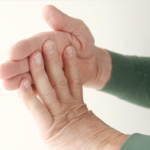(Reuters Health)—People with thumb-base osteoarthritis (OA) who receive a combination of conservative treatments, including education in self-management, ergonomics and hand exercises, may experience clinically meaningful improvements in hand function, a study suggests.
Researchers randomized 204 people with thumb-base OA (1:1) to receive education on self-management and ergonomics alone (comparator) or in combination with a base-of-thumb splint, hand exercises and diclofenac sodium 1% gel (intervention). The primary endpoints were improvements in hand function scores (0–30 point Functional Index for Hand OA) and pain (0–100 mm visual analog scale) at six weeks.
Hand function improved significantly more in the intervention group than the comparator (1.7 point between-group difference), while both groups experienced similar improvements in pain (4.2 mm between-group difference).
By week 12, hand function improvements remained significantly greater in the intervention group (2.4 point between-group difference), and pain improvements were also significantly better for the intervention group (8.6 mm between-group difference).
“These results suggest that a combination of a relatively safe conservative intervention provides clinically meaningful effects that are durable in nature,” says senior study author David Hunter, a professor at the University of Sydney and Royal North Shore Hospital, Australia.
“All of the interventions tested are widely and readily available in clinical practice,” Dr. Hunter says by email.
For participants who reported joint swelling at baseline, similar proportions of people in both groups reported the absence of joint swelling at week 6.
However, pain medication use was less common from weeks 2 to 6 among people in the intervention group.
There were no serious adverse events, although all 34 non-serious events occurred in the intervention group. The most common events were skin reactions and pain exacerbations from exercise.
One limitation of the study is the lack of long-term follow up, the authors note in JAMA Internal Medicine. Another limitation is that many patients were on NSAIDs at baseline, often for other conditions; while participants were asked not to start new medications during the study, researchers didn’t monitor to determine compliance.1
Even so, it’s not surprising that a combination of interventions were more effective in reducing pain and increasing function, particularly because splinting has been previously proven an effective intervention for thumb-base osteoarthritis, says Alexandra MacKenzie, clinical lead for the Hand and Upper Extremity Therapy Center at the Hospital For Special Surgery, New York City.
“The combination of splinting, topical NSAIDs, and exercises can help calm an irritated joint, while ergonomic modifications can lead to long-term behavioral changes that serve to protect the joint,” Dr. MacKenzie, who wasn’t involved in the study, says by email.

